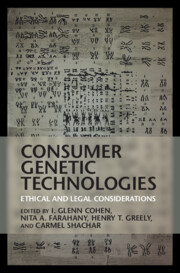Book contents
- Consumer Genetic Technologies
- Consumer Genetic Technologies
- Copyright page
- Contents
- Contributors
- Acknowledgments
- Introduction
- Part I Consumer Genetic Technologies: Rights, Liabilities, and Other Obligations
- Introduction to Part I
- 1 Liability Implications of Direct-to-Consumer Genetic Testing
- 2 Consuming Genetics As a Life Insurance Consumer
- 3 In Favor of an Action for Genetic Conversion
- 4 Direct-to-Consumer Genomics and Personal Health Data
- 5 Governance in the Era of CRISPR and DIY-Bio
- Part II Privacy in the Age of Consumer Genetics
- Part III Tinkering with Ourselves: The Law and Ethics of DIY Genomics
- Part IV Consumer Genetics and Identity
- Part V The Impact of Genetic Information
5 - Governance in the Era of CRISPR and DIY-Bio
Regulatory Guidance of Human Genome Editing at the National and Global Levels
from Part I - Consumer Genetic Technologies: Rights, Liabilities, and Other Obligations
Published online by Cambridge University Press: 27 August 2021
- Consumer Genetic Technologies
- Consumer Genetic Technologies
- Copyright page
- Contents
- Contributors
- Acknowledgments
- Introduction
- Part I Consumer Genetic Technologies: Rights, Liabilities, and Other Obligations
- Introduction to Part I
- 1 Liability Implications of Direct-to-Consumer Genetic Testing
- 2 Consuming Genetics As a Life Insurance Consumer
- 3 In Favor of an Action for Genetic Conversion
- 4 Direct-to-Consumer Genomics and Personal Health Data
- 5 Governance in the Era of CRISPR and DIY-Bio
- Part II Privacy in the Age of Consumer Genetics
- Part III Tinkering with Ourselves: The Law and Ethics of DIY Genomics
- Part IV Consumer Genetics and Identity
- Part V The Impact of Genetic Information
Summary
This chapter analyzes the technology of human genome editing with a focus on the ethical issues involved and offers guidance as how best to regulate this technology. First, this chapter explains several common types of gene editing technologies and then analyzes the ethical implications of the two primary therapeutic uses of gene editing: somatic and germline. Primary ethical analysis will focus on the bioethical principles of autonomy, beneficence, non-maleficence, and social justice; analysis will then provide a weighing of these principles and likely consequences–noting the biologic differences between somatic versus germline treatments. Somatic gene editing is generally more confined to the individual, while germline editing changes the genes of cells that are passed sexually to offspring, thus having the power to shape the human genome generationally--the ultimate consequence of which is the influence and shaping of human evolution. In conclusion, the chapter argues the consequences of somatic vs. germline genome editing demand that, when considering the proper emphasis of a regulatory paradigm, somatic editing should be regulated under a nationally guided framework and germline editing should be regulated under both a nationally and globally guided framework.
- Type
- Chapter
- Information
- Consumer Genetic TechnologiesEthical and Legal Considerations, pp. 65 - 76Publisher: Cambridge University PressPrint publication year: 2021

